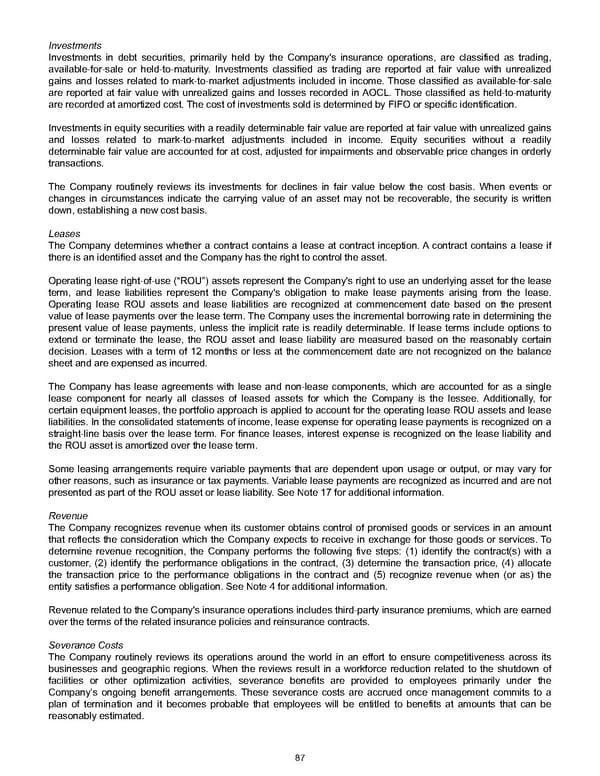Investments Investments in debt securities, primarily held by the Company's insurance operations, are classified as trading, available-for-sale or held-to-maturity. Investments classified as trading are reported at fair value with unrealized gains and losses related to mark-to-market adjustments included in income. Those classified as available-for-sale are reported at fair value with unrealized gains and losses recorded in AOCL. Those classified as held-to-maturity are recorded at amortized cost. The cost of investments sold is determined by FIFO or specific identification. Investments in equity securities with a readily determinable fair value are reported at fair value with unrealized gains and losses related to mark-to-market adjustments included in income. Equity securities without a readily determinable fair value are accounted for at cost, adjusted for impairments and observable price changes in orderly transactions. The Company routinely reviews its investments for declines in fair value below the cost basis. When events or changes in circumstances indicate the carrying value of an asset may not be recoverable, the security is written down, establishing a new cost basis. Leases The Company determines whether a contract contains a lease at contract inception. A contract contains a lease if there is an identified asset and the Company has the right to control the asset. Operating lease right-of-use (“ROU”) assets represent the Company's right to use an underlying asset for the lease term, and lease liabilities represent the Company's obligation to make lease payments arising from the lease. Operating lease ROU assets and lease liabilities are recognized at commencement date based on the present value of lease payments over the lease term. The Company uses the incremental borrowing rate in determining the present value of lease payments, unless the implicit rate is readily determinable. If lease terms include options to extend or terminate the lease, the ROU asset and lease liability are measured based on the reasonably certain decision. Leases with a term of 12 months or less at the commencement date are not recognized on the balance sheet and are expensed as incurred. The Company has lease agreements with lease and non-lease components, which are accounted for as a single lease component for nearly all classes of leased assets for which the Company is the lessee. Additionally, for certain equipment leases, the portfolio approach is applied to account for the operating lease ROU assets and lease liabilities. In the consolidated statements of income, lease expense for operating lease payments is recognized on a straight-line basis over the lease term. For finance leases, interest expense is recognized on the lease liability and the ROU asset is amortized over the lease term. Some leasing arrangements require variable payments that are dependent upon usage or output, or may vary for other reasons, such as insurance or tax payments. Variable lease payments are recognized as incurred and are not presented as part of the ROU asset or lease liability. See Note 17 for additional information. Revenue The Company recognizes revenue when its customer obtains control of promised goods or services in an amount that reflects the consideration which the Company expects to receive in exchange for those goods or services. To determine revenue recognition, the Company performs the following five steps: (1) identify the contract(s) with a customer, (2) identify the performance obligations in the contract, (3) determine the transaction price, (4) allocate the transaction price to the performance obligations in the contract and (5) recognize revenue when (or as) the entity satisfies a performance obligation. See Note 4 for additional information. Revenue related to the Company's insurance operations includes third-party insurance premiums, which are earned over the terms of the related insurance policies and reinsurance contracts. Severance Costs The Company routinely reviews its operations around the world in an effort to ensure competitiveness across its businesses and geographic regions. When the reviews result in a workforce reduction related to the shutdown of facilities or other optimization activities, severance benefits are provided to employees primarily under the Company’s ongoing benefit arrangements. These severance costs are accrued once management commits to a plan of termination and it becomes probable that employees will be entitled to benefits at amounts that can be reasonably estimated. 87
 Annual Report Page 96 Page 98
Annual Report Page 96 Page 98